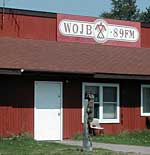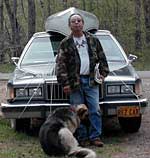The Words of the Past
By Elizabeth Stawicki, Minnesota Public Radio
July 2, 2001
At one time, more than 300 American Indian languages were spoken in the U.S. But with each passing generation, many of the indigenous languages have died; others are on the verge of disappearing. With that in mind, tribes from northern Wisconsin and Minnesota are trying to keep their language from going silent and gain new insight into how their ancestors viewed the world.
AS A YOUNG GIRL nearly 30 years ago, Camille Lacapa remembers hearing old men speak on the streets of Hayward, Wisconsin. "They seemed like they were having a real good time and I stood there for a moment watching these men and they were chewing tobacco. I didn't know who they were, they were all talking, probably making fun of me," she recalls.
Lacapa can count on her hands the number of fluent speakers now on the Lac Courte Oreilles reservation in northwestern Wisconsin. Most of them, she says, are over 60 years old. Some, appear on WOJB, the area radio station at least four times a day. Lacapa, the station's general manager, produces the segments which are intended to not only teach the language, but also provide an insight into the Ojibwe traditional way of life that is synonymous with nature.
One elder says in Ojibwe, "As spring approaches, it starts to warm up. The snow should begin to start melting. If it is still cold, there will be a hard crust on the snow. Look, go outside. Is there a hard crust on the snow yet?"
Ojibwe is part of the large Algonquian family of related American Indian languages, which also includes Cree, Arapaho and Cheyenne. One linguistic source, the Ethnologue of World Languages, says there are about 35,000 speakers in the world, but most of them are in isolated areas of Canada.
One speaker at Lac Courte Oreilles is Keller Paap, who is unusual because he's fluent in and only 30 years old.
"If we are to be Ojibwe and we do not speak our language anymore, we are merely descendants of Ojibwe people", he says.
Paap, who's from the Red Cliff band, grew up in the Twin Cities and wasn't
raised with the language. But in college, where he studied art and Native
American studies, he went through a transformation by learning . He says he
began to feel the deep connection among the language, the earth and the
Annishenaabeg, the word for what the call themselves - the first people.
"With our languages we don't have a motherland to go back to; this is where the languages have come from, and for so long. And so they're connected to the land and the region," Paap says.
About 100 miles northwest of the Lac Courte Oreilles reservation is the Fond Du Lac reservation in northern Minnesota. On this day when the fog is so dense it looks like apparitions floating across the dirt roads, it's easy to imagine hearing some of the earliest human language spoken in these north woods.
Writer Jim Northrup gives his name in Ojibwe and says his clan is bear; he's from the Fond Du Lac reservation and lives in Sawyer. He's lived among Minnesota's white birch and jack pine most of his life. He remembers speaking some Ojibwe as a child until boarding school where speaking the language earned him a slap on the neck from teachers. Now, he says, speaking Ojibwe brings him peace.
"It feels good," he says. "It brings back memories of my parents, my grandparents, all the old people that used to talk. So hearing it again, it's a good feeling," Northrup says.
Northrup, along with other tribal members, meet twice a year for a language
conference in Cloquet. On this day, Northrup's 11-year-old grandson, Ezigaa,
will deliver the opening prayer. Northrup calls him Ezigaa, which means
wood tick in Ojibwe, because the boy clings so fiercely when he hugs.
On the drive from Northrup's home to the conference, he gives his grandson some last-minute tutoring on a prayer that in part asks the spirits and creator to help them learn the Ojibwe language.
This year's statewide conference draws only 35 people. Some sit around a 15-foot table at the Cloquet community center where facilitators show slides of different activities and challenge the participants to say the corresponding Ojibwe words like shi-shi-bug, which means duck.
Northrup and many others say they feel a spiritual strength after the language exercise, almost like being at a revival. He says he hopes Indians and non-Indians will try to understand even a bit of the Ojibwe language because he says doing so would go a long way toward healing wounds of the past.
"If they start to learn the language, then respect will naturally follow, a mutual respect," he says. If somebody takes the trouble to learn the language or learn a little bit of it, they're respecting me. So, I like the idea of anybody and everybody learn and use the language. It's important."
By Elizabeth Stawicki, Minnesota Public Radio
July 2, 2001
|
|
RealAudio |
At one time, more than 300 American Indian languages were spoken in the U.S. But with each passing generation, many of the indigenous languages have died; others are on the verge of disappearing. With that in mind, tribes from northern Wisconsin and Minnesota are trying to keep their language from going silent and gain new insight into how their ancestors viewed the world.
| |
|
|
|
||
AS A YOUNG GIRL nearly 30 years ago, Camille Lacapa remembers hearing old men speak on the streets of Hayward, Wisconsin. "They seemed like they were having a real good time and I stood there for a moment watching these men and they were chewing tobacco. I didn't know who they were, they were all talking, probably making fun of me," she recalls.
Lacapa can count on her hands the number of fluent speakers now on the Lac Courte Oreilles reservation in northwestern Wisconsin. Most of them, she says, are over 60 years old. Some, appear on WOJB, the area radio station at least four times a day. Lacapa, the station's general manager, produces the segments which are intended to not only teach the language, but also provide an insight into the Ojibwe traditional way of life that is synonymous with nature.
One elder says in Ojibwe, "As spring approaches, it starts to warm up. The snow should begin to start melting. If it is still cold, there will be a hard crust on the snow. Look, go outside. Is there a hard crust on the snow yet?"
Ojibwe is part of the large Algonquian family of related American Indian languages, which also includes Cree, Arapaho and Cheyenne. One linguistic source, the Ethnologue of World Languages, says there are about 35,000 speakers in the world, but most of them are in isolated areas of Canada.
One speaker at Lac Courte Oreilles is Keller Paap, who is unusual because he's fluent in and only 30 years old.
"If we are to be Ojibwe and we do not speak our language anymore, we are merely descendants of Ojibwe people", he says.
| |
|
|
|
||
"With our languages we don't have a motherland to go back to; this is where the languages have come from, and for so long. And so they're connected to the land and the region," Paap says.
About 100 miles northwest of the Lac Courte Oreilles reservation is the Fond Du Lac reservation in northern Minnesota. On this day when the fog is so dense it looks like apparitions floating across the dirt roads, it's easy to imagine hearing some of the earliest human language spoken in these north woods.
Writer Jim Northrup gives his name in Ojibwe and says his clan is bear; he's from the Fond Du Lac reservation and lives in Sawyer. He's lived among Minnesota's white birch and jack pine most of his life. He remembers speaking some Ojibwe as a child until boarding school where speaking the language earned him a slap on the neck from teachers. Now, he says, speaking Ojibwe brings him peace.
"It feels good," he says. "It brings back memories of my parents, my grandparents, all the old people that used to talk. So hearing it again, it's a good feeling," Northrup says.
| |
|
|
|
On the drive from Northrup's home to the conference, he gives his grandson some last-minute tutoring on a prayer that in part asks the spirits and creator to help them learn the Ojibwe language.
This year's statewide conference draws only 35 people. Some sit around a 15-foot table at the Cloquet community center where facilitators show slides of different activities and challenge the participants to say the corresponding Ojibwe words like shi-shi-bug, which means duck.
Northrup and many others say they feel a spiritual strength after the language exercise, almost like being at a revival. He says he hopes Indians and non-Indians will try to understand even a bit of the Ojibwe language because he says doing so would go a long way toward healing wounds of the past.
"If they start to learn the language, then respect will naturally follow, a mutual respect," he says. If somebody takes the trouble to learn the language or learn a little bit of it, they're respecting me. So, I like the idea of anybody and everybody learn and use the language. It's important."


